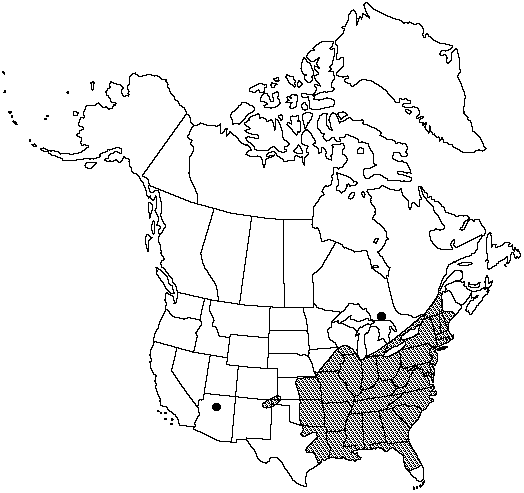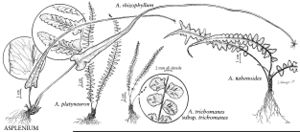Difference between revisions of "Asplenium platyneuron"
Prelim. Cat. 3. 1888.
FNA>Volume Importer |
imported>Volume Importer |
||
| (7 intermediate revisions by 2 users not shown) | |||
| Line 8: | Line 8: | ||
}} | }} | ||
|common_names=Ebony spleenwort;doradille ébène | |common_names=Ebony spleenwort;doradille ébène | ||
| − | |basionyms={{Treatment/ID/ | + | |special_status={{Treatment/ID/Special_status |
| + | |code=F | ||
| + | |label=Illustrated | ||
| + | }} | ||
| + | |basionyms={{Treatment/ID/Basionym | ||
|name=Acrostichum platyneuron | |name=Acrostichum platyneuron | ||
|authority=Linnaeus | |authority=Linnaeus | ||
| + | |rank=species | ||
| + | |publication_title=Sp. Pl. | ||
| + | |publication_place=2: 1069. 1753 | ||
}} | }} | ||
|synonyms={{Treatment/ID/Synonym | |synonyms={{Treatment/ID/Synonym | ||
|name=Asplenium platyneuron var. bacculum-rubrum | |name=Asplenium platyneuron var. bacculum-rubrum | ||
|authority=(Fernald) Fernald | |authority=(Fernald) Fernald | ||
| − | }}{{Treatment/ID/Synonym | + | |rank=variety |
| + | }} {{Treatment/ID/Synonym | ||
|name=Asplenium platyneuron var. incisum | |name=Asplenium platyneuron var. incisum | ||
|authority=(E. C. Howe) Robinson | |authority=(E. C. Howe) Robinson | ||
| + | |rank=variety | ||
}} | }} | ||
|hierarchy=Aspleniaceae;Asplenium;Asplenium platyneuron | |hierarchy=Aspleniaceae;Asplenium;Asplenium platyneuron | ||
| Line 26: | Line 35: | ||
}}<!-- | }}<!-- | ||
| − | --><span class="statement" id="st- | + | --><span class="statement" id="st-undefined" data-properties=""><b>Roots </b>not proliferous. <b>Stems</b> short-creeping, unbranched; scales dark brown to black throughout, narrowly linear-deltate, 2–4 × 0.3–0.6 mm, margins entire. <b>Leaves</b> ± dimorphic; fertile leaves taller and more erect than sterile leaves. <b>Petiole</b> reddish brown throughout, lustrous, 1–10 cm, 1/4–1/3 length of blade; indument of dark brown to black, filiform scales at base. <b>Blade</b> lustrous, linear to narrowly oblanceolate, 1-pinnate throughout, 4–50 × 2–5(–7) cm, thin, glabrous, or occasionally sparsely pubescent; base gradually tapered; apex acute, not rooting. <b>Rachis</b> reddish or purplish brown throughout, lustrous, glabrous. <b>Pinnae</b> in 15–45 pairs, oblong to quadrangular; medial pinnae 1–2.5 × 0.3–0.5 cm; base with conspicuous acroscopic and sometimes basiscopic auricle, this overlapping rachis; margins crenate to serrulate, sometimes more deeply incised in robust specimens; apex acute to obtuse. <b>Veins</b> free, evident. <b>Sori</b> 1–12 pairs per pinna, on both basiscopic and acroscopic sides. <b>Spores</b> 64 per sporangium. <b>2n</b> = 72.</span><!-- |
-->{{Treatment/Body | -->{{Treatment/Body | ||
| Line 32: | Line 41: | ||
|elevation=0–1300 m | |elevation=0–1300 m | ||
|distribution=Ont.;Que.;Ala.;Ark.;Ariz.;Colo.;Conn.;Del.;D.C.;Fla.;Ga.;Ill.;Ind.;Iowa;Kans.;Ky.;La.;Maine;Md.;Mass.;Mich.;Minn.;Miss.;Mo.;Nebr.;N.H.;N.Mex.;N.J.;N.Y.;N.C.;Ohio;Okla.;Pa.;R.I.;S.C.;Tenn.;Tex.;Vt.;Va.;W.Va.;Wis.;s Africa. | |distribution=Ont.;Que.;Ala.;Ark.;Ariz.;Colo.;Conn.;Del.;D.C.;Fla.;Ga.;Ill.;Ind.;Iowa;Kans.;Ky.;La.;Maine;Md.;Mass.;Mich.;Minn.;Miss.;Mo.;Nebr.;N.H.;N.Mex.;N.J.;N.Y.;N.C.;Ohio;Okla.;Pa.;R.I.;S.C.;Tenn.;Tex.;Vt.;Va.;W.Va.;Wis.;s Africa. | ||
| − | |discussion=<p>The combining author for Asplenium platyneuron is often given as Oakes ex D. C. Eaton; see D. B. Lellinger (1981) for justification of the authorship employed here.</p><!-- | + | |discussion=<p>The combining author for <i>Asplenium platyneuron</i> is often given as Oakes ex D. C. Eaton; see D. B. Lellinger (1981) for justification of the authorship employed here.</p><!-- |
| − | --><p>Asplenium platyneuron is remarkable in that it occurs in southern Africa as well as in North America. No other North American fern has this distribution. Asplenium platyneuron is an ecological generalist and is particularly characteristic of disturbed woodlands. This species is migrating northward on the northern portions of its range in the upper Great Lake states (W. H. Wagner Jr. and D. M. Johnson 1981). Proliferous buds on the lowest pinnae allow formation of clumps with stems at several layers in the litter. Asplenium platyneuron hybridizes with A. rhizophyllum, A. trichomanes (producing A. × virginicum Maxon), A. pinnatifidum, A. ruta-muraria (producing A. × morganii W. H. Wagner & F. S. Wagner), A. bradleyi, and A. montanum (producing sterile A. bradleyi).</p> | + | --><p><i>Asplenium platyneuron</i> is remarkable in that it occurs in southern Africa as well as in North America. No other North American fern has this distribution. <i>Asplenium platyneuron</i> is an ecological generalist and is particularly characteristic of disturbed woodlands. This species is migrating northward on the northern portions of its range in the upper Great Lake states (W. H. Wagner Jr. and D. M. Johnson 1981). Proliferous buds on the lowest pinnae allow formation of clumps with stems at several layers in the litter. <i>Asplenium platyneuron</i> hybridizes with <i>A. rhizophyllum</i>, <i>A. trichomanes</i> (producing A. × virginicum Maxon), <i>A. pinnatifidum</i>, <i>A. ruta-muraria</i> (producing A. × morganii W. H. Wagner & F. S. Wagner), <i>A. bradleyi</i>, and <i>A. montanum</i> (producing sterile <i>A. bradleyi</i>).</p> |
|tables= | |tables= | ||
|references= | |references= | ||
| Line 42: | Line 51: | ||
-->{{#Taxon: | -->{{#Taxon: | ||
name=Asplenium platyneuron | name=Asplenium platyneuron | ||
| − | |||
|authority=(Linnaeus) Britton | |authority=(Linnaeus) Britton | ||
|rank=species | |rank=species | ||
| Line 55: | Line 63: | ||
|publication title=Prelim. Cat. | |publication title=Prelim. Cat. | ||
|publication year=1888 | |publication year=1888 | ||
| − | |special status= | + | |special status=Illustrated |
| − | |source xml=https:// | + | |source xml=https://bitbucket.org/aafc-mbb/fna-data-curation/src/2e0870ddd59836b60bcf96646a41e87ea5a5943a/coarse_grained_fna_xml/V2/V2_377.xml |
|genus=Asplenium | |genus=Asplenium | ||
|species=Asplenium platyneuron | |species=Asplenium platyneuron | ||
| − | |||
| − | |||
| − | |||
| − | |||
| − | |||
| − | |||
| − | |||
| − | |||
| − | |||
| − | |||
| − | |||
| − | |||
| − | |||
| − | |||
| − | |||
| − | |||
| − | |||
| − | |||
| − | |||
| − | |||
| − | |||
| − | |||
| − | |||
| − | |||
| − | |||
| − | |||
| − | |||
| − | |||
| − | |||
| − | |||
| − | |||
| − | |||
| − | |||
| − | |||
| − | |||
| − | |||
| − | |||
| − | |||
| − | |||
| − | |||
| − | |||
| − | |||
| − | |||
| − | |||
}}<!-- | }}<!-- | ||
-->[[Category:Treatment]][[Category:Asplenium]] | -->[[Category:Treatment]][[Category:Asplenium]] | ||
Latest revision as of 20:23, 5 November 2020
Roots not proliferous. Stems short-creeping, unbranched; scales dark brown to black throughout, narrowly linear-deltate, 2–4 × 0.3–0.6 mm, margins entire. Leaves ± dimorphic; fertile leaves taller and more erect than sterile leaves. Petiole reddish brown throughout, lustrous, 1–10 cm, 1/4–1/3 length of blade; indument of dark brown to black, filiform scales at base. Blade lustrous, linear to narrowly oblanceolate, 1-pinnate throughout, 4–50 × 2–5(–7) cm, thin, glabrous, or occasionally sparsely pubescent; base gradually tapered; apex acute, not rooting. Rachis reddish or purplish brown throughout, lustrous, glabrous. Pinnae in 15–45 pairs, oblong to quadrangular; medial pinnae 1–2.5 × 0.3–0.5 cm; base with conspicuous acroscopic and sometimes basiscopic auricle, this overlapping rachis; margins crenate to serrulate, sometimes more deeply incised in robust specimens; apex acute to obtuse. Veins free, evident. Sori 1–12 pairs per pinna, on both basiscopic and acroscopic sides. Spores 64 per sporangium. 2n = 72.
Habitat: Forest floor or on rocks, often invading masonry and disturbed soils
Elevation: 0–1300 m
Distribution

Ont., Que., Ala., Ark., Ariz., Colo., Conn., Del., D.C., Fla., Ga., Ill., Ind., Iowa, Kans., Ky., La., Maine, Md., Mass., Mich., Minn., Miss., Mo., Nebr., N.H., N.Mex., N.J., N.Y., N.C., Ohio, Okla., Pa., R.I., S.C., Tenn., Tex., Vt., Va., W.Va., Wis., s Africa.
Discussion
The combining author for Asplenium platyneuron is often given as Oakes ex D. C. Eaton; see D. B. Lellinger (1981) for justification of the authorship employed here.
Asplenium platyneuron is remarkable in that it occurs in southern Africa as well as in North America. No other North American fern has this distribution. Asplenium platyneuron is an ecological generalist and is particularly characteristic of disturbed woodlands. This species is migrating northward on the northern portions of its range in the upper Great Lake states (W. H. Wagner Jr. and D. M. Johnson 1981). Proliferous buds on the lowest pinnae allow formation of clumps with stems at several layers in the litter. Asplenium platyneuron hybridizes with A. rhizophyllum, A. trichomanes (producing A. × virginicum Maxon), A. pinnatifidum, A. ruta-muraria (producing A. × morganii W. H. Wagner & F. S. Wagner), A. bradleyi, and A. montanum (producing sterile A. bradleyi).
Selected References
None.
